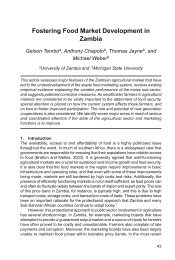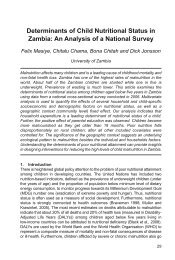Introduction to Basic Legal Citation - access-to-law home
Introduction to Basic Legal Citation - access-to-law home
Introduction to Basic Legal Citation - access-to-law home
You also want an ePaper? Increase the reach of your titles
YUMPU automatically turns print PDFs into web optimized ePapers that Google loves.
neighboring communities, presence of captive audiences, and unique congestion and security<br />
problems. These characteristics both attest <strong>to</strong> the special purpose of the Port Authority air<br />
terminals and distinguish them from traditional public fora. In previous cases, this Court has<br />
examined the nature of alleged public fora <strong>to</strong> determine their public forum status. See, e.g.,<br />
Kokinda, 497 U.S. 720; Greer, 424 U.S. 824; Lehman, 418 U.S. 298 .<br />
4. Captive Audiences<br />
The presence of captive audiences in air terminals distinguish such terminals from the<br />
traditional public fora of streets and parks. Captive audiences exist throughout the air<br />
terminals – at enplaning and deplaning points, at ticket counters, security checkpoints,<br />
baggage conveyor belts, and car rental and other ground transportation counters. At all of<br />
these locations, travelers tend <strong>to</strong> remain in place in order <strong>to</strong> complete travel-related tasks<br />
(Superintendent's Statement at 58-60 (JA 458); Anderson Affidavit at 9 (JA 488)). See<br />
Doughty, supra note 13, at 7. As noted by Justice Douglas with regard <strong>to</strong> the patrons of public<br />
transportation vehicles, the rights of such captive audiences "<strong>to</strong> be free from forced intrusions<br />
on their privacy" would be violated if they were forced <strong>to</strong> be the object of uninvited<br />
persuasion. Lehman, 418 U.S. at 307 (1974) (Douglas, J., concurring); cf. Consolidated<br />
Edison Co. of N.Y. v. Public Serv. Comm'n, 447 U.S. 530, 542 (1980).<br />
This Court has explicitly stated that a public forum does not exist merely because persons are<br />
freely permitted <strong>to</strong> enter a government owned site. Indeed, the Court has ". . . expressly<br />
rejected the suggestion that 'whenever members of the public are permitted freely <strong>to</strong> visit a<br />
place owned or operated by the Government, then that place becomes a "public forum" for<br />
purposes of the First Amendment.'" United States v. Albertini, 472 U.S. 675, 686 (1985)<br />
(quoting Greer, 424 U.S. at 836); see also United States v. Grace, 461 U.S. 171, 177 (1983).<br />
Finally, it is equally clear that the usefulness of government property as a site for expressive<br />
activity does not make such property a traditional public forum under applicable Supreme<br />
Court precedent. In Members of the City Council v. Taxpayers for Vincent, 466 U.S. 789<br />
(1984), which held that lampposts are not public fora for the posting of signs, this Court<br />
rejected in unequivocal terms the proposition that a publicly-owned facility is a public forum<br />
because it would be a useful place for the communication of ideas: "Lampposts can of course<br />
be used as signposts, but the mere fact that government property can be used as a vehicle for<br />
communication does not mean that the Constitution requires such uses <strong>to</strong> be permitted. Cf.<br />
United States Postal Serv. v. Greenburgh Civic Ass'ns, 453 U.S. at 131." Id. at 814 (footnote<br />
omitted); see also Albertini, 472 U.S. at 686; Greer, 424 U.S. at 838 n.10.<br />
Plaintiffs' reference <strong>to</strong> the alleged decline of down<strong>to</strong>wn street life by the development of<br />
skyways and other street alternatives in city centers is clearly irrelevant <strong>to</strong> the issue at bar.<br />
The merits or demerits of such developments should be debated by planning commissions or<br />
zoning boards who determine the nature of our cities. See, e.g., William H. Whyte, City 193-<br />
221 (1988). Any perceived failure of responsible planning bodies <strong>to</strong> foster the development of<br />
urban streetscapes provides no basis for holding that the Port Authority air terminals are<br />
public fora.<br />
Second, the alleged role of rail terminals as public fora is irrelevant because rail terminals,<br />
unlike Port Authority air terminals, are located in the center of a city. If the concourse of<br />
143




